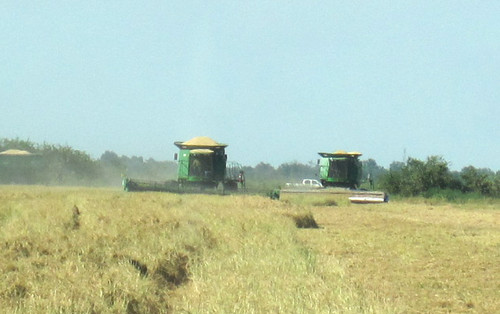As rice harvest approaches, growers hope for higher temperatures, less rain
By Ryan McGeeney
U of A System Division of Agriculture
Aug. 11, 2017
Fast Facts:
- July, August rain, cool temps may slow harvest
- Sunshine needed to lower moisture levels in grain
(423 words)
(Download this story in MS Word here.)
STUTTGART, Ark. – After a tumultuous spring, in which rains and flooding upended more than 10 percent of total rice acreage throughout Arkansas, swallowing sunk input costs and costing the state an estimated $175 million in crop losses, the nation’s No. 1 rice producer is slowly moving toward harvest.
Jarrod Hardke, extension rice agronomist for the University of Arkansas System Division of Agriculture, said the trend in recent years toward early planting has caused rice combines to appear in fields a little earlier each August, although relatively cool summer temperatures and recent rains have delayed the process for many in eastern Arkansas.
“We had some people start last week, which is definitely early,” Hardke said. “2012 is the barometer for early planning progress — it stands as the record, and we actually had some rice harvested in July that year.
“There was probably some potential for that this year, but the temperatures just didn’t stay high enough, so the crop didn’t quite progress as fast,” he said. “We didn’t have anywhere near the heat necessary for that.”
According to a U.S. Department of Agriculture acreage report published in July, original estimates of rice acreage in Arkansas dropped from a March estimate of about 1.19 million acres planted to a July estimate of 1.17 million acres planted. However, after the flooding in late April and early May, the final harvested acreage is expected to be 1.11 million acres.
Rice harvest typically begins in the middle of August, Hardke said, with the “heart” of the harvest occurring on or around Sept. 1. While the state hasn’t suffered another deluge like those in the spring, intermittent rains in July and August may push many harvesting operations to the latter weeks of this month.
“We’re actually waiting for it to dry out to the point where we can take an accurate moisture sample in research trials,” Hardke said. “We have dew from the night before not drying out until some time after lunch each day. “We need the temperatures to rise a little and have some sunshine to dry the rice out before we can really get rolling on the harvest. So far, that’s not really happening. You see the occasional combine running, but I’m not getting word of much running this week.”
A sunny streak doesn’t seem to be in the cards. The National Weather Service at Little Rock is forecasting at least a 30 percent chance of rain through next Wednesday.
To learn about Arkansas row crops, contact your local Cooperative Extension Service agent or visit www.uaex.uada.edu.
About the Division of Agriculture
The University of Arkansas System Division of Agriculture’s mission is to strengthen agriculture, communities, and families by connecting trusted research to the adoption of best practices. Through the Agricultural Experiment Station and the Cooperative Extension Service, the Division of Agriculture conducts research and extension work within the nation’s historic land grant education system.
Pursuant to 7 CFR § 15.3, the University of Arkansas System Division of Agriculture offers all its Extension and Research programs and services (including employment) without regard to race, color, sex, national origin, religion, age, disability, marital or veteran status, genetic information, sexual preference, pregnancy or any other legally protected status, and is an equal opportunity institution.
# # #
Media Contact: Mary Hightower
Dir. of Communication Services
U of A System Division of Agriculture
Cooperative Extension Service
(501) 671-2126
mhightower@uada.edu
Related Links
